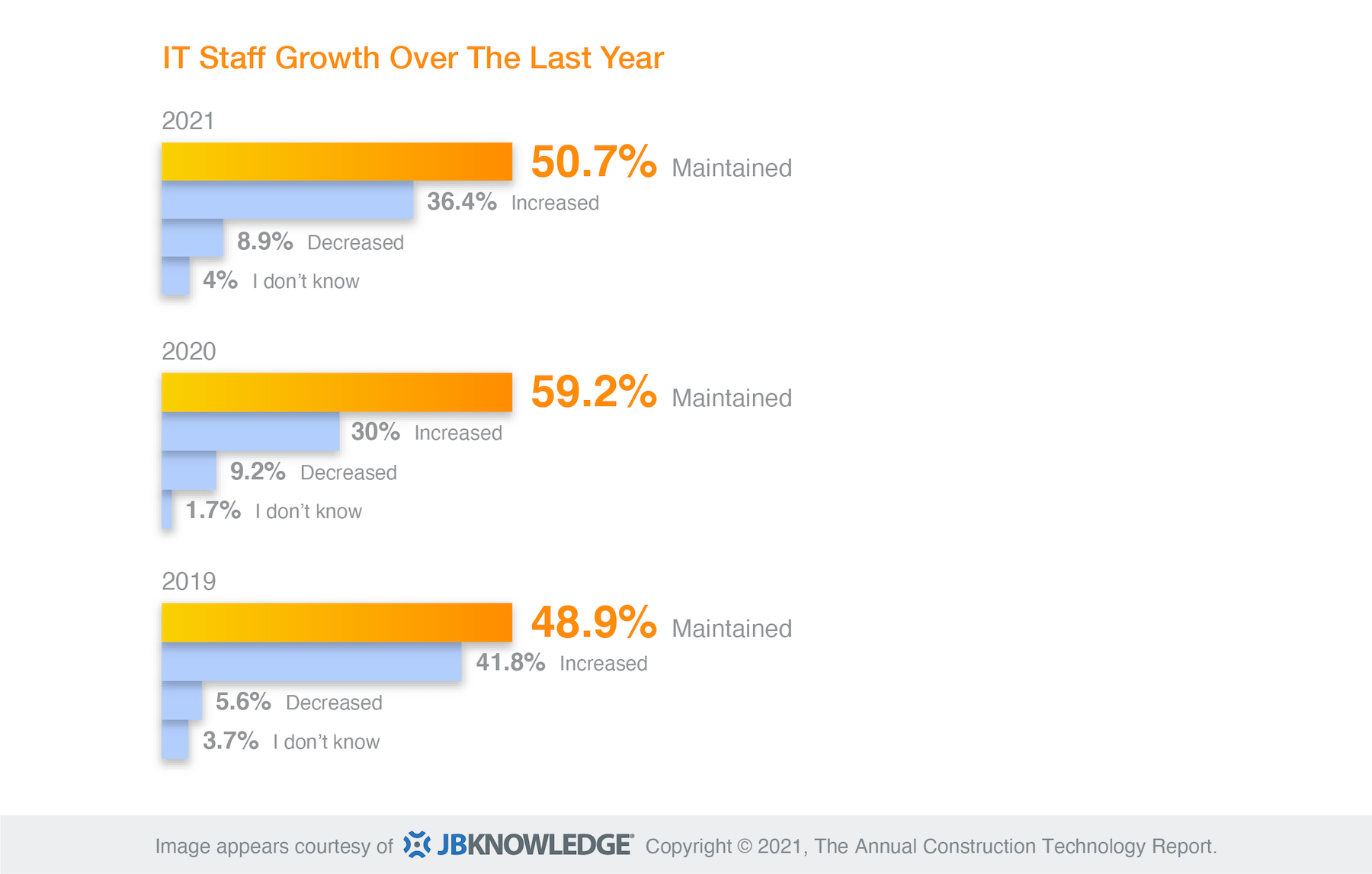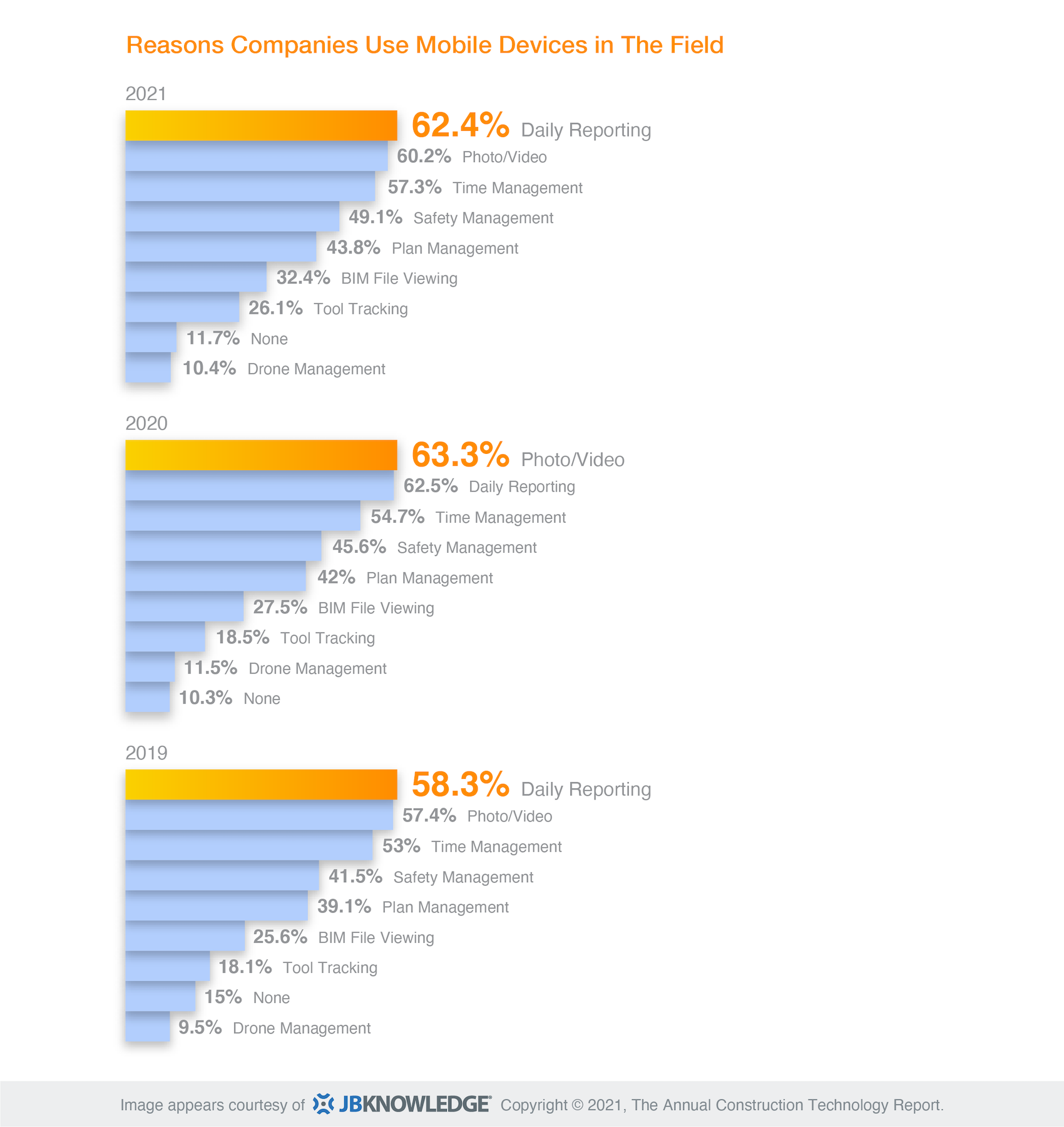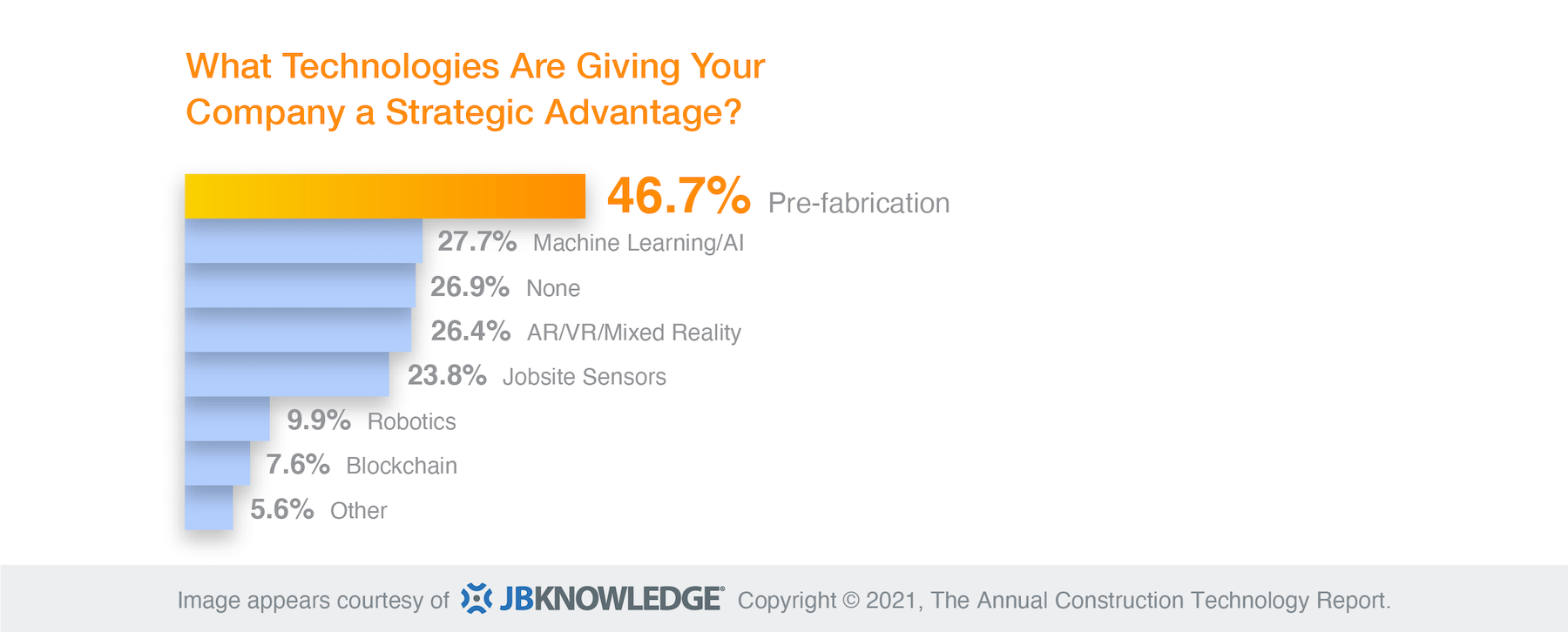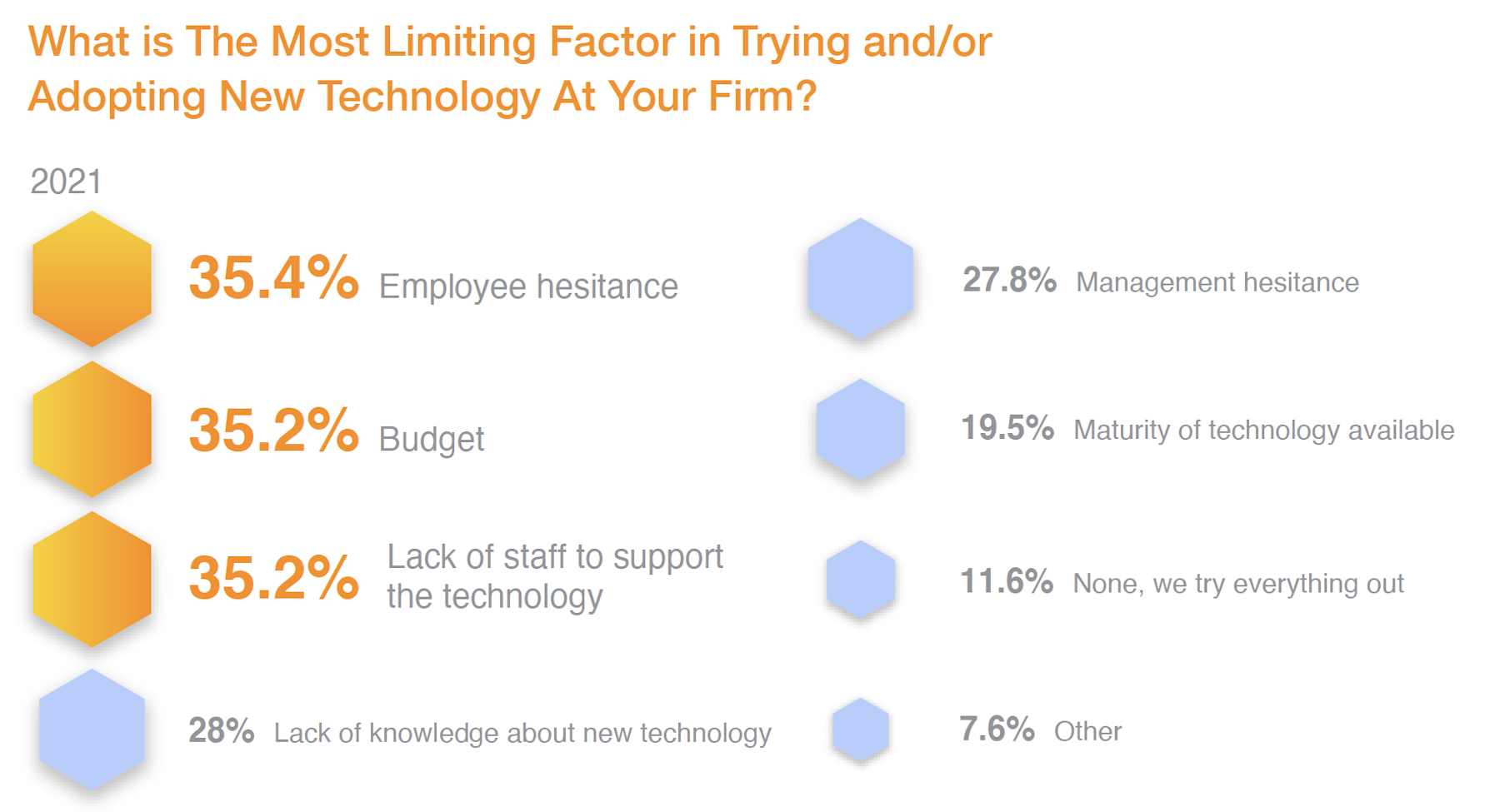In 2021, a record $4.5 billion were invested in Construction Technology startups, triple the amount in 2020, according Cemex Ventures. But there remains a disconnect between this outpouring for innovation and what’s actually being used in the field and back offices.
For example, less than half of contractor companies have departments dedicated to Information Technology, and even fewer don’t bill for IT expenditures. Over the past few years, construction companies have been reducing dedicated IT support and relying more on outsourcing some, if not all, of their IT functions.
Those are some of the findings that emerge from the 10th edition of JBKnowledge’s Annual Construction Technology Report, which was recently released. The report was produced in partnership with the Mechanical Contractors Association of America, the National Electrical Contractors Association, the Construction Financial Management Association, the Sheet Metal and Air Conditioning Contractors’ National Association, and the Construction Sciences Department of Texas A&M University.
JBKnowledge did not reveal the exact number of respondents to its survey except to tell BD+C that around 2,000 were from the construction industry in both field and administrative capacities. The survey was conducted in June and July 2021.
More than half of the total respondents to JBKnowleldge’s survey was between the ages of 42 and 61. Just over one-fifth (21 percent) was female, and the highest percentage of respondents (30 percent) was executives. Nearly three-quarters (73.8 percent) identified commercial building as their primary industry. While the survey received responses from 29 countries, 96.3 percent arrived from North America.
The report betrays an industry with too many companies that don’t prioritize IT. “Many construction companies fail to realize that an investment in IT will [lead to] greater profitability and increased ROI,” the report contends. “It’s no coincidence that construction companies are measuring on the lower-end of productivity as compared to other industries.”

While three-fifths of those polled say their companies have between one and five employees dedicated to IT on their payrolls, more than one-third spends less that 1 percent of annual sales on IT. “Construction spending on IT is behind the curve.”
MOBILE APP INTEGRATION A CHALLENGE
The report is not without its contradictions. Respondents were generally satisfied with the IT training and resources their companies provided them. While 43.4 percent says their companies have dedicated R&D employees, 56 percent doesn’t have dedicated R&D budgets. “The most important thing to remember about Research & Development is: If you make R&D a ‘spare time’ endeavor, you will only receive ‘spare time’ results,” the report cautions.
More than half of the respondents says their companies’ cybersecurity includes using mobile device management, two-factor authentication, and cyber liability insurance. (Twelve percent of those polled says their companies experienced a data breach in 2021, and another 6 percent answered “I don’t know” to the question about breaches.)

The top reason why respondents say they use mobile devices in the field is for daily reporting (62.4 percent), followed by photo/video capture (60.2 percent) and time management (57.3 percent) “Anyone who has been on the fence about whether a mobile app is necessary, the construction industry has spoken—mobile apps are key.” But technology integration remains a “big challenge” for many companies: more than half of all respondents still manually transfers data for apps without integrations. A surprising 15.3 percent of respondents doesn’t transfer data between apps at all, up from 11.8 percent in 2019.
Nearly all of those polled use smartphones for daily work purposes. But only around one-third says that their companies request that personal devices be secure and approved. (35.3 percent doesn’t use such personal devices at work.)
PREFAB A ‘COMPETITIVE ADVANTAGE’

Based on the survey’s responses, Procore is the favored app for managing plans, daily reporting, safety management, time management, and image capture; Bluebeam for viewing BIM files; DroneDeploy for controlling drones; and ToolWatch for tool tracking.
Workflows likely to rely on dedicated software include accounting/ERP (83 percent), estimating (60.7 percent), and project management (58.2 percent). However, more than three-fifths of those polled say they still use spreadsheets for estimating instead of software, and more than two-fifths use spreadsheets over software for project management.
The most popular software includes Sage for accounting/ERP (21.3 percent of respondents cited it), OnScreen Takeoff for takeoffs (37.6 percent), custom in-house software for estimating (17 percent), BuildingConnected for bid management (31.2 percent), Microsoft Project for scheduling (59.8 percent), Procore for project management (46.2 percent), and Consential for client relationship management (32.4 percent).
As for tech innovations, 36.6 percent of respondents says their companies use drones on jobsites (although that percentage was down from previous years). And nearly two fifths (38.6 percent) say their companies have built with prefabricated components in the previous 12 months. Nearly half of respondents sees prefab as a competitive advantage.
Conversely, a portion of contractors still isn’t sold on Building Information Modeling (BIM): 35 percent says their firms outsource it, and 27.8 percent says their firms don’t bid on projects that involve BIM or Virtual Design and Construction (VDC). “The good news is, for the first time in the past five years more respondents reported their company had a BIM department,” the report states.
Related Stories
AEC Tech | Oct 3, 2024
4 ways AI impacts building design beyond dramatic imagery
Kristen Forward, Design Technology Futures Leader, NBBJ, shows four ways the firm is using AI to generate value for its clients.
Digital Twin | Aug 21, 2024
Digital twins: Transforming operations for greater efficiency
While efforts to improve building efficiency have been iterative, recent advancements have significantly enhanced the interaction between facility managers, building owners, and their facilities.
Affordable Housing | Aug 7, 2024
The future of affordable housing may be modular, AI-driven, and made of mushrooms
Demolished in 1989, The Phoenix Ironworks Steel Factory left a five-acre hole in West Oakland, Calif. After sitting vacant for nearly three decades, the site will soon become utilized again in the form of 316 affordable housing units.
Great Solutions | Jul 23, 2024
41 Great Solutions for architects, engineers, and contractors
AI ChatBots, ambient computing, floating MRIs, low-carbon cement, sunshine on demand, next-generation top-down construction. These and 35 other innovations make up our 2024 Great Solutions Report, which highlights fresh ideas and innovations from leading architecture, engineering, and construction firms.
Virtual Reality | Jul 8, 2024
Can a VR-enabled AEC firm transform your project?
With the aid of virtual reality and three-dimensional visualization technologies, designers, consultants, and their clients can envision a place as though the project were in a later stage.
Affordable Housing | May 30, 2024
General contractor’s keys to a successful affordable housing project
General contractors can have tremendous influence over a project’s success in terms of schedule, budget, and quality. However, to ensure a project is put on this path, there are a few factors that must be considered.
AEC Tech | Apr 30, 2024
Lack of organizational readiness is biggest hurdle to artificial intelligence adoption
Managers of companies in the industrial sector, including construction, have bought the hype of artificial intelligence (AI) as a transformative technology, but their organizations are not ready to realize its promise, according to research from IFS, a global cloud enterprise software company. An IFS survey of 1,700 senior decision-makers found that 84% of executives anticipate massive organizational benefits from AI.
AEC Innovators | Apr 26, 2024
National Institute of Building Sciences announces Building Innovation 2024 schedule
The National Institute of Building Sciences is hosting its annual Building Innovation conference, May 22-24 at the Capital Hilton in Washington, D.C. BI2024 brings together everyone who impacts the built environment: government agencies, contractors, the private sector, architects, scientists, and more.
BIM and Information Technology | Mar 11, 2024
BIM at LOD400: Why Level of Development 400 matters for design and virtual construction
As construction projects grow more complex, producing a building information model at Level of Development 400 (LOD400) can accelerate schedules, increase savings, and reduce risk, writes Stephen E. Blumenbaum, PE, SE, Walter P Moore's Director of Construction Engineering.
AEC Tech | Mar 9, 2024
9 steps for implementing digital transformation in your AEC business
Regardless of a businesses size and type, digital solutions like workflow automation software, AI-based analytics, and integrations can significantly enhance efficiency, productivity, and competitiveness.

















